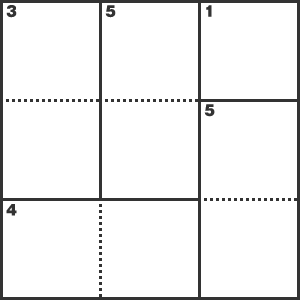WELCOME TO MATHDOKU
At MathDoku you can play this highly addicting logic and math puzzle game. It is available in both online and printable formats for free. Are you up for the challenge?
The games at MathDoku are is loosely similar to killer sudoku and based on the same rules of KENKEN™, an educational puzzle invented by Tetsuya Miyamoto in Japan. MathDoku games go by a number of names including KenKen™, KenDoKu™, kenduko, cancan, square wisdom, minuplu, calcudoku, and/or latincalc. It is also slightly similar to a crossword or jigsaw puzzle since it requires trial and error to solve.
The games at MathDoku are available in 3 formats, a 4x4, 6x6, and 8x8 and difficulties ranging between easy, medium, hard, and no-op.
There are also iGoogle Gadgets available to add to any website including your Google homepage. For more information and directions how, visit wikiHow. Then, go to Google's directory or click below to add games to your homepage:
4x4 original
4x4 no-operations
6x6 original
6x6 no-operations
RECENT NEWS
Mar 7 09 - for all the people printing hardcopies, there's now an answers section at http://www.mathdoku.com/answers, cheers
Mar 1 09 - upgraded the layout to v2, hopefully it loads faster and is a little more intuitive and user friendly, enjoy
Feb 28 09 - just moved here from http://www.webkendoku.com/, sorry about the inconvenience
DISCLAIMER
MathDoku is an unofficial web site and is not associated with Nextoy or the KenKen™ brand in any way.
ABOUT THE GAME KENKEN™
MathDoku is a mathematical and logical puzzle based on KenKen™ and loosely similar to sudoku.
Puzzles can be solved by combining the four main mathematical functions of addition, subtraction, multiplication and division. To train the brain the puzzles are offered without any instruction. There are important keys to be found but no fixed starting place and no method of progression that can be learned as a strategy. The brain is forced to dart between competing theories. It's impossible to solve puzzles without the scientific process of trial and error and that's the rationale behind these puzzles.
KenKen™ was invented by a Japanese mathematics teacher Tetsuya Miyamoto and introduced to The Times via Robert Fuhrer of Nextoy and Chess Champion Dr. David Levy and recognized for its depth and magnitude by The Times features editor, Mr. Michael Harvey. KenKen™ brain training puzzles are a trademark of Nextoy, LLC. Toy inventor Robert Fuhrer, founder of Nextoy, discovered KenKen™ (aka KEN-KEN) in Japan as the original books published by educational publisher Gakken Co., Ltd. as Kashikoku naru Puzzle, and has been instrumental in introducing them to the western world.
OBJECTIVE
Depending on the size of the grid, fill-in the table with the appropriate numbers where:
- 4x4 tables use only numbers 1-4
- 6x6 tables use only numbers 1-6
- 8x8 tables use only numbers 1-8
- Each row contains exactly one of each digit with no repeats
- Each column contains exactly one of each digit with no repeats
- Each bold-outlined group of cells contains a clue with a number and symbol. The symbol represents the mathematical operation and the number represents the result.
- For example, if the clue for a group of 2 blocks is "7+", some possible answers could be 1+6, 3+4, or 2+5
HOW TO PLAY
- Review the table and each cell
- When you've identified the value of a cell, click in the cell and type your answer
- If you get stuck, you can click the hint button
- Continue answering to fill-in the table
- You can change an answer by clicking in the cell and deleting your old answer
- If you mess up, you can click the start over button the clear the table
- When you're done, click the check answer button to see if you got it right
- Click the new game button if you wanna play another game
EXAMPLE
The example below uses only addition to simplify things.

"1" - single block are always the clue
"2 & 1"- sum of 3, 1's cannot repeat in the first row
"3 & 1" - 3 is the last number in the first column, plus 1 equals the clue of 4
"2 & 3" - 2 is the last number in the bottom row, plus 3 equals the clue of 5
"3 & 2" - last number in the first and second rows and the middle column, and add up to the clue
ABOUT US
This KenKen™ adventure started in late November 2008.
My girlfriend found the game KenKen™ in a local newspaper. Having both been fans of sudoku (although she was significantly better than me), we immediately took a liking and interest to this new type of game. We played KenKen™ games as often as we could and always looked for the local newspaper to play another game, especially when we were at coffee shops where newspapers were plentiful and many times free.
This interest rapidly grew into an obsession. Newspaper versions were not enough. A quick search of the interwebs yielded few results and proved ineffective as KenKen™ printable versions burned a lot of consumables like paper, ink, and electricity (we're trying to live a little greener). To ease the addiction, we set out to make our own interactive, online version. And in less than a month the initial site, http://www.webkendoku.com/, was born. Shortly afterwards, in February 2009, we were notified by Robert Fuhrer that the use of "kendoku" in the domain name infringed on their trademark of "KenDoKu™". To avoid any legal disputes, WebKendoku.com closed as we transitioned to this new site. We apologize for the inconvenience and hope you enjoy this site and the game as much as we do.
But, we could not have possibly done it alone.
First and foremost, I want to give credit and thank my wonderful and amazing girlfriend. Thank you for your patience and understanding, I know there were a lot of late nights. And thank you for your loving support, without you this would not have been possible.
I Love You!
BLOG
This page is not yet available.
We are currently looking for a lightweight, inline blog solution. If you have any recommendations, drop us a line in the comments
. Until then, we have a presence on twitter at
http://twitter.com/mathdoku.
Until then, play another game.
PRIVACY POLICY
The privacy of all visitors to MathDoku is important to us.
At MathDoku, we recognize that privacy of your personal information is important. Here is information on what types of personal information we receive and collect when you use and visit MathDoku, and how we safeguard your information. We never sell your personal information to third parties.
Log Files
As with most other websites, we collect and use the data contained in log files. The information in the log files include your IP (internet protocol) address, your ISP (internet service provider), the browser you used to visit our site (Firefox, Safari, Internet Explorer, etc), the time you visited our site and which pages you visited throughout our site.
Cookies and Web Beacons
We do use cookies to store information, such as your personal preferences when you visit our site. This could include only showing you a popup once in your visit, or the ability to login to some of our features, such as forums.
We also use third party advertisements on MathDoku to support our site. Some of these advertisers may use technology such as cookies and web beacons when they advertise on our site, which will also send these advertisers (such as Google through the Google AdSense program) information including your IP address, your ISP , the browser you used to visit our site, and in some cases, whether you have Flash installed. This is generally used for geotargeting purposes or showing certain ads based on specific sites visited.
You can choose to disable or selectively turn off our cookies or third-party cookies in your browser settings, or by managing preferences in programs such as Norton Internet Security. However, this can affect how you are able to interact with our site as well as other websites. This could include the inability to login to services or programs, such as logging into forums or accounts.
CONTACT US
Twitter :
http://twitter.com/mathdoku
Blogger :
http://mathdoku.blogspot.com
Comments :
comments












